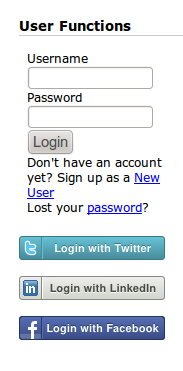OAuth
What is OAuth?
The idea behind OAuth is to get rid of the need to register separately with all the websites out there that require registration before you can use them. Instead of having to keep track of all the different accounts, you can use one login on every website that supports OAuth.
To quote the OAuth homepage:
- An open protocol to allow secure API authorization in a simple and standard method from desktop and web applications.
OAuth is a free and open protocol. It is not owned by any corporation.
OAuth in Geeklog
OAuth support in Geeklog differs slightly from the Remote Authentication support, but only in that it requires a separate login prompt.
To activate OAuth support, go to the Configuration Admin panel:
- Configuration > Geeklog > Users and Submissions > Users > User Login Method[OAuth]
Set this option to "true", then save the configuration change. When you log out, you will see a new login prompt in your site's User Functions block, below the normal login options:
As the "http" suggests, your OAuth is really a URL that you use for the login (hence the need for a separate login prompt). Note that you will not enter your password on the site you are about to log in to. Instead, you will be taken to your OAuth provider (the place where you registered your OAuth) and enter the password there. So the Geeklog site will never see your OAuth password - it will only get an "okay" back from the OAuth provider if you authenticated successfully.
Once a user has logged in via OAuth, they are just like any other Geeklog user. They can be added to groups, change their profile, do whatever else you allow your users to do on your site. And yes, OAuth users can also be banned.
Users that log in through OAuth are automatically added to the "Remote Users" group.
Limitations
- Currently, OAuth 1.0 is supported (OAuth 2.0 is still in development).
